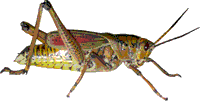Entomology Collections, General

Entomology Papers from Other Sources
Document Type
Article
Date of this Version
1998
Abstract
The within-plant distribution of the tarnished plant bug, Lygus lineolaris (Palisot de Beauvois), in cotton, Gossypium hirsutum L., was determined during June through the 1st week in August in 1992 and 1993 at Stoneville, MS. Locations of adults and nymphs in cotton were determined weekly using visual searches of whole plants or plant sections (mainstem terminals, upper and lower plant halves below the mainstem terminals). The distributions of adults and nymphs found in the morning (0900-1100 hours) in 1992 were not significantly different from their distributions found in the afternoon (1300-1500 hours). Adults had a significantly different distribution than nymphs on vegetative structures (mainly leaves), fruiting structures (squares, bolls, and blooms) and mainstem terminals in both years. The distributions of adults and nymphs also were significantly different in both years on the mainstem terminals and upper and lower plant halves below the terminal. Nymphs and adults were found in both years to have 75% of their populations (on average) in the mainstem terminal plus the fruit and vegetative structures on the top 6 nodes of the plant. Nymphs showed a strong preference for fruiting structures, and high percentages of adults were found on vegetative structures through the first 3 wk of squaring (June through the 1st week in July) in both years. Adults then became more dispersed among the vegetative structures, fruit, and mainstem terminals. These types of distributions would make the drop cloth an excellent method for sampling nymphs, whereas the sweep net would work well for adults especially through the first 3 wk of squaring. If visual examination of plants for nymphs and adults is used to sample cotton, it should include mainstem terminals plus vegetative and fruiting structures in the upper halves of plants.


Comments
Published in Environ. Entomol. 27(5): 1089-109.3 (1998).